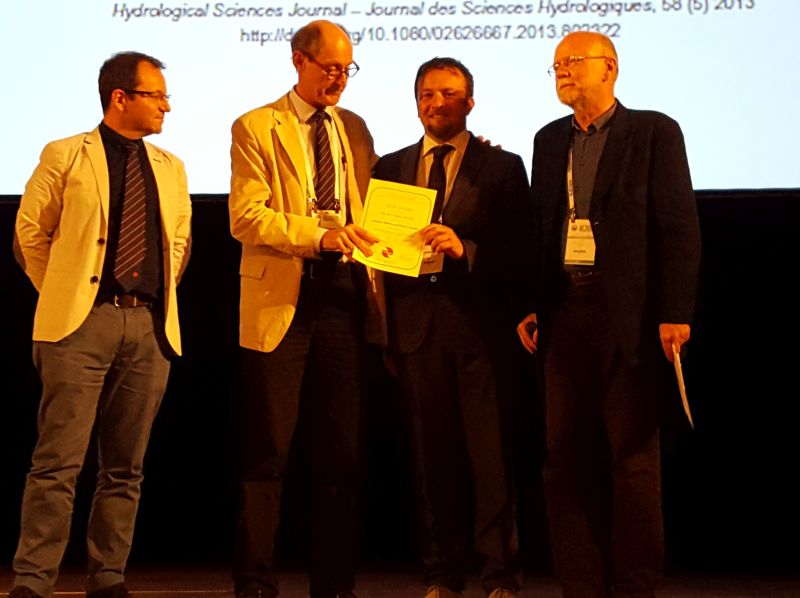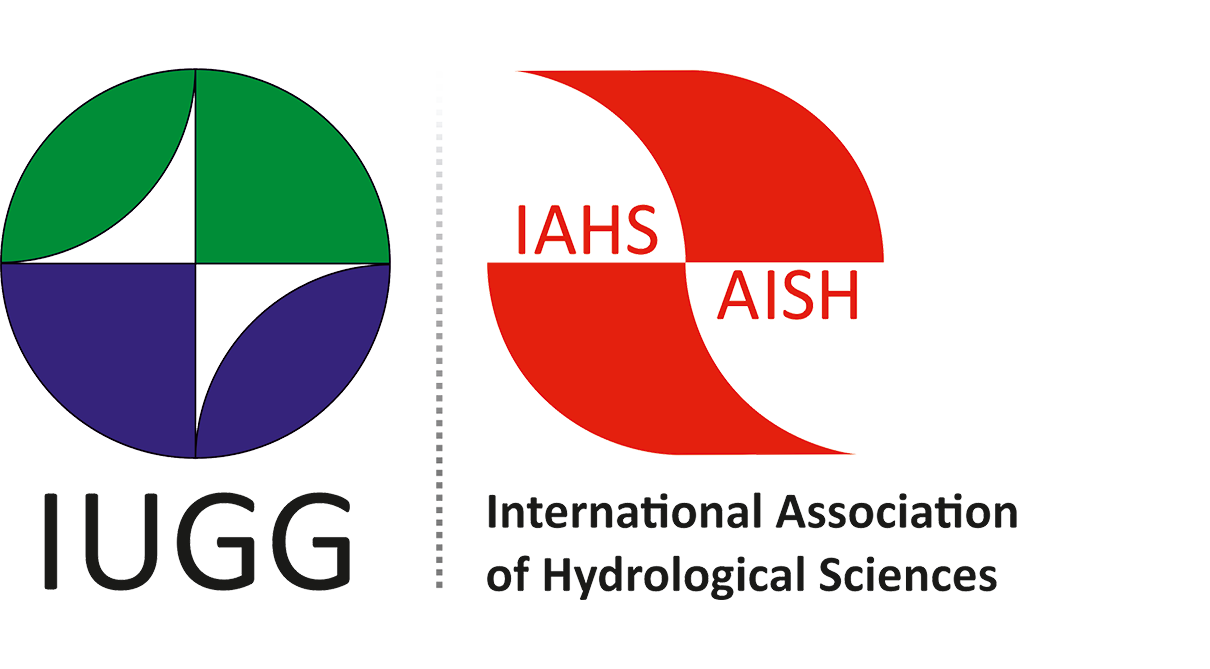Citation on the occasion of bestowing the 2015 Tison Award to Antonino Maltese and Fulvio Capodici

Left to Right: Christophe Cudennec (Secretary General, IAHS), Hubert Savenije (President, IAHS), Antonino Maltese (Tison Award Recipient), Zbigniew W. Kundzewicz (Retired Co-editor, HSJ). Photo courtesy of C. Neale.
As chairman of the Jury of the 2015 IAHS Tison Award, I have the privilege to read a citation honouring the winners of the Award this year. The Award is granted for an outstanding paper published by IAHS in two-year period prior to the deadline for nominations. The aim of this Award is to promote excellent research by young hydrologists, where the definition of “young” is that the author(s) were under 41 years of age at the time the paper was accepted for publication. The Award consists of a citation in the name of L.J. Tison, the former IAHS Secretary-General, a check for US $1,000 and a free subscription to HSJ for one year. Since the successful paper is jointly authored by eligible (age-wise) co-authors, the monetary award will be divided equally between two eligible co-authors.
The winning paper is:
It was prepared by a group of scientists from two countries – Italy and UK. The Italian scientists live and work in Sicily and represent Università degli Studi di Palermo. Two Italian co-authors, Antonino Maltese and Fulvio Capodici, are eligible for the Tison Award.
The winning paper deals with the “thermal inertia” method to identify spatial distribution of soil water content in bare or sparsely-vegetated soils. As the study area, the authors selected a small experimental watershed in Sicily, where they acquired remotely sensed images and in situ data.
Soil water content is a very important variable, for both practical and theoretical reasons. It is of importance for vegetation, drought modelling and management (e.g. determination of irrigation needs). It is also important for setting up the initial conditions for flood forecasting models – depending on soil water storage a given rainfall event may or may not lead to flooding.
Soil water content is highly variable even within small areas, hence it is very necessary to enrich the ground-truth data, acquired by point observations, by remotely-sensed information covering large areas and providing fine spatial resolution. Since remotely sensed imagery does not directly measure soil water, relationships are sought between soil water and image radiometric properties that can be more readily quantified, such as a so-called “thermal inertia” method. The principle underlying this method is that soil water content can be indirectly inferred by measuring the temporal change of temperature. In order to retrieve the soil moisture maps, the authors of this innovative paper had to solve important, and difficult, practical problems.
In the conclusions of their award-winning paper, the authors summarized the strengths and weaknesses of the method. They noted a limitation – their method works mainly on bare (or at most sparsely-vegetated) soils, since it simplifies the contribution of sensible and latent heat fluxes.
As the chairman of the 2015 Tison Award Jury I have to mention that this year the competition was very tough. There were several fine papers that did nearly equally well in the evaluation process. I am very glad to note that the Award is getting more and more popular. There were several excellent candidate papers, rendering the final selection difficult. One of the 2015 Tison Award Jury members, who strongly supported the paper by Maltese et al., found this winning paper an interesting compromise between observations, modelling and theory. I tend to agree with him.
Announcing the Tison Award, during an IAHS Plenary Session at an IUGG/IAHS General Assembly, in the beautiful city of Prague, I feel like embarking on a sentimental journey. Since 1983, i.e. over the last 32 years, I have attended all but one IAHS general and scientific assemblies, held every two years. In 1987, at the General Assembly in Vancouver, I received the first Tison Award ever bestowed. Since then, I have been heavily involved in the Tison Award process, as a member or a chair of the Tison Award Jury and the one announcing the Award at the Assembly.
The monetary part of the Award is symbolic, but its moral and societal value is very high. Every laureate considers the Tison Award to be a major step in her or his career. I wish the laureates of the 2015 Tison Award every success in their further scientific careers.
Zbigniew W. Kundzewicz
This paper is available open access: http://www.tandfonline.com/doi/full/10.1080/02626667.2013.802322
TISON AWARD 2015 ACCEPTANCE NOTE
Dear colleagues, dear Prof. Kundzewicz, it is an honor for me to receive the award from the Scientist who won the first Tison Award in 1987. I thank all IAHS members that participated in the consideration of this paper.
When on the evening of the 8th of April Prof. Christophe Cudennec, as Secretary General of the International Association of Hydrological Sciences (IAHS), informed us that our article was being awarded with the Tison Award 2015 for young hydrologists, I was very surprised and couldn’t believe what I was reading. While I was eagerly awaiting to share my happiness with my loved ones; I realized I was receiving this notice by Prof. Cudennec who also won the same prize in 2007.
Two of the paper authors, were eligible at the date of acceptance of the paper: a colleague of mine and great friend Fulvio Capodici who helped me in writing the code, and myself. We are both young researchers at the Department of Civil Engineering, Environmental, Aerospace, of Materials of the University of Palermo.
The paper draws its inspiration from my PhD thesis, and thus, I’m even more pleased for this prize; however, I would like to consider this, as an award for the whole research group of Remote sensing in hydrology, at my University in its unity. The research group is coordinated by Prof. Goffredo La Loggia, and led by Prof. Giuseppe Ciraolo, and I express my gratitude to both of them, for their enlightened guidance, and also for their trust in us.
The group began research in applied remote sensing almost 20 years ago, and I have been part of this team for 15 years now; working hard, with scientific rigor and dedication, aiming to learn and to contribute building up a novel discipline for our University.
I fell in love with remote sensing research starting with the project writing, airborne flight planning, in situ data acquisition, and data analysis and processing towards a thesis and manuscript writing during and after my PhD studies. The PhD research activity that led to this paper was carried out in two countries: in Italy at the University of Palermo, under the supervision of my PhD tutor Prof. Marcella Cannarozzo, and at the School of Geographical Sciences of the University of Bristol in the United Kingdom, under the guide of Prof. Paul David Bates.
Finally, I would like to thank Dr Frances Watkins, Associate Editor of the Hydrological Sciences Journal, for supporting us during the long paper review process; I’m also grateful to the whole 2015 Tison Award Jury members for acknowledging the quality of the manuscript and conferring us this prestigious award.
I’m glad to share these feelings with all the colleagues working hard for the love of science and attending this ceremony.
Thank you.
(Antonino Maltese)
